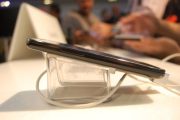The arrival of Samsung's Galaxy S II phones has been a long time coming. We first saw the next generation of Samsung's popular line of Android phones back in February at Mobile World Congress. After many successful months in Europe, the Galaxy S II line of phones is finally coming to U.S. shores. The first of the phones, theSamsung Epic Touch 4G($200 with a two-year contract with Sprint; price as of September 12, 2011) will be available starting on September 16.
Ridiculously Thin

 The Epic Touch might be a bit larger than the previous generation of phones, but it is incredibly thin. Measuring 5.1 inches by 2.7 inches by 0.38 inch, the Touch feels pretty comfortable in hand--and this is coming from somebody with small hands! Samsung phones have a bit of a reputation for being plasticky, and the Epic Touch unfortunately falls under that descriptor. In her hands on of the Epic Touch at Samsung's launch even, my colleague Melanie Pinola remarked that it felt "less refined" than AT&T's Galaxy S II version.
The Epic Touch might be a bit larger than the previous generation of phones, but it is incredibly thin. Measuring 5.1 inches by 2.7 inches by 0.38 inch, the Touch feels pretty comfortable in hand--and this is coming from somebody with small hands! Samsung phones have a bit of a reputation for being plasticky, and the Epic Touch unfortunately falls under that descriptor. In her hands on of the Epic Touch at Samsung's launch even, my colleague Melanie Pinola remarked that it felt "less refined" than AT&T's Galaxy S II version.On the bottom of the phone, you'll find the MHL port, a feature we've seen on many of this year's high-end smartphones. The MHL specification, which stands for Mobile High Definition Link, is a 1080p HD video and digital audio interface for connecting smartphones and other portable devices (tablets, cameras, and the like) to HDTVs. So what's the big deal? It simultaneously provides power to your phone--something that HDMI cables don't do.
Super AMOLED Plus Display
The 4.52-inch Super AMOLED Plus display on the Epic Touch is quite nice, but text isn't quite as sharp as what we saw on the European Galaxy S II. The Epic Touch's display is slightly larger than the European version (which has a 4.3-inch display) so it seems like the text sharpness may have been compromised by larger screen real estate. The text is still quite readable, but it is something I noticed right away upon using the phone.
Otherwise, the display's colors looked bright, details were crisp, and the viewing angles were very good. Blacks were deep, and colors were richly saturated without being overdone. Even when held in direct sunlight, the Epic Touch's display remained incredibly visible. Whites had a bit of a bluish tint, but it wasn't too noticeable. According to Samsung, Super AMOLED Plus displays have 50 percent more subpixels than the first-generation Super AMOLED displays (seen on the Vibrant, Mesmerize, and other Galaxy S phones) and perform even better than their predecessors in bright light.
Android Gingerbread With TouchWiz 4.0
The revamped TouchWiz 4.0 is fairly similar to the previous version, but it has a few aesthetic and functional enhancements here and there. For instance, the new lock screen displays missed calls and unread text messages; you can swipe these notifications rather than having to unlock your phone and then dig through menus to find the missed messages. The Epic Touch's keyboard isn't the native Android one, but it retains the multitouch key-chording feature (you can simultaneously press Shift and a letter to produce a symbol or number--no need to switch between modes) and the ability to use your voice to correct words as you type.
Taking a page from (or directly ripping off) HTC Sense, TouchWiz lets you pinch your homescreen to see thumbnail-size versions of all of your screens. Samsung borrowed another feature from HTC Sense, too: When the phone is ringing or playing music, you can silence it by flipping it face-down on a surface.
Contacts gets some cool new gesture-based functions. Swipe right on a friend's name, and you'll start a call with them; swipe left on their name, and you'll jump to the SMS composer, which you can use to send them a text message. Each of your contact's cards comes with your communication history--for example, when you last called, texted, or emailed the person.
One funny new feature is the ability to reject a call by sending a text message. Let's say that your brother is calling to ask when you're going to pay him back for dinner the other night. A menu will come up giving you the option to answer the call, hang up, or reject it with a text that says "I'll pay you back tomorrow!"
All of Samsung's Galaxy S II phones have six-axis motion sensing, powered by an accelerometer and a gyroscope. This feature is great for gaming, but Samsung also throws in some gesture-based phone controls. For example, you can zoom in and out of images in your gallery or in the browser by tilting the phone. This feature feels a bit awkward and unnecessary, however; I can't see myself ever using it.
TouchWiz isn't for everyone, so be sure to spend some time with it before purchasing a Galaxy S II phone.
Multimedia and Apps
Because this is a Sprint phone, you'll find all of the usual bloatware: Sprint Music Plus, Sprint Radio, Sprint TV and Movies, and Sprint NASCAR. You also get a game called N.O.V.A. HD and various apps--including Samsung's AllShare app for sharing media over DLNA servers.
Perhaps the coolest app Samsung provides on the phone (and on all Galaxy S II phones we've seen) is the company's own Kies Air. The app lets you view call logs, videos, photos, bookmarks, and IMs, and send SMS messages from PC. In order for the app to work, you'll have to install it on your PC and connect it to the same Wi-Fi network as your phone.
Like all Galaxy S phones, the Epic Touch provides the Media Hub for movie and TV-watching. Video looked fantastic on the handset's display and played back smoothly. Even if you don't like Samsung's Media Hub, you'll want to watch a lot of movies and TV shows on this phone. Unlike the European version, the Epic Touch 4G does not have the Readers or Music Hub for purchasing ebooks or MP3s, respectively.
Performance
Like the AT&T Galaxy S phone, the Epic Touch is powered by a 1.20GHz dual-core Samsung Exynos processor. The Epic Touch booted up in 20 seconds, which is pretty fast; in contrast, theDroid Bionic took 43 seconds to turn on fully.
We also tested the phone using Qualcomm's new benchmarking app, Vellamo, to see how a Samsung processor would fare against its competitors. The Epic Touch 4G earned a very impressive score of 914, putting it right behind the Galaxy Tab 10.1 for overall performance and ahead of two phones running Qualcomm chips--the HTC Sensation 4G and the HTC EVO 3D. You should take these results with a grain of salt, since Qualcomm manufactures the app, but the data is interesting to compare.
I experienced reliably good Sprint WiMax 4G coverage in San Francisco. I had a strong 4G signal pretty much everywhere I went in the city. Sprint's 4G network paired with the Samsung Exynos dual-core processor makes for some excellent Web browsing, too. Over 4G, PCWorld.com (the full site) loaded in a speedy 12.1 seconds. Image-heavy site TheBoldItalic.com loaded in 10.1 seconds, and media-heavy ThrasherMagazine.com loaded in 13.6 seconds.
Of course, 4G coverage and signal strength vary depending on where you live in the country and whether your city even offers 4G. We have good 4G coverage in San Francisco; but in our 4G Phone Shootout, Sprint had the poorest country-wide coverage.
Call quality over Sprint was very good overall. My friends and family said that they could hear my voice perfectly and described it as sounding natural.
Superb 8-Megapixel Camera
When we reviewed the European version of the Galaxy S II, we were impressed by its 8-megapixel camera. Luckily, Samsung seems not to have changed the sensor for the U.S. versions. The Epic Touch took excellent photos indoors and out. My only complaint is that colors in my indoor photos looked a bit oversaturated. Details were quite sharp and I didn't detect any graininess or pixelation. The shutter speed on the camera was fast enough to capture photos of sports, kids, and other quick-moving subjects. Again, I must lament the lack of a physical shutter button, but the camera's quality makes up for it.
Like the Motorola Photon 4G, HTC Sensation 4G, and the LG Optimus 3D, the Epic Touch 4G supports up to 1080p HD video capture. Video quality was good: The Epic Touch could handle fast-moving cars and slower-moving people without distortion or pixelation.
Bottom Line
We'll be conducting formal lab testing over the next few days, but right now, it looks as though the Epic Touch 4G is the fastest Android smartphone out there. On top of its speediness, it has a superslim design, a gorgeous display, and a superb camera. My only complaint is the amount of carrier and manufacturer-added bloatware on the phone, but that's pretty much par for the course these days










